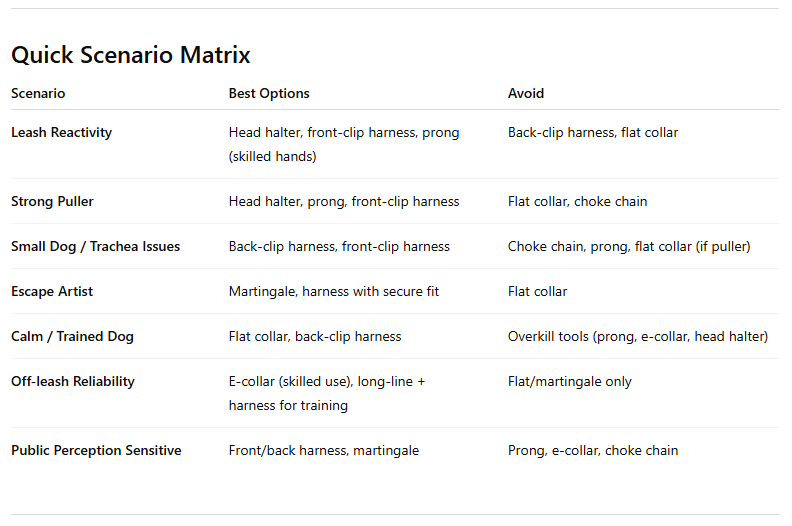Dog Collars & Halters Guide.
Applied Guide: Collars & Halters by Scenario
Flat Collar
✅ Good for
Dogs that are already trained to walk on a loose leash.
Everyday wear for ID tags.
Small or mellow dogs that don’t pull.
❌ Not good for
Strong pullers (trachea risk).
Dogs that lunge at triggers (can cause choking).
Escape-prone dogs with narrow heads.
Martingale (Limited Slip)
✅ Good for
Escape-artist breeds (greyhounds, whippets, huskies).
Dogs that slip flat collars but don’t pull excessively.
A balance between security and comfort.
❌ Not good for
Heavy pullers (still applies neck pressure).
Owners who leave collars on unsupervised (can catch).
Choke Chain (Slip Collar)
✅ Good for
Honestly, few cases—historically used for competition obedience with handlers who knew how to apply quick, fair corrections.
❌ Not good for
Everyday use (too risky for neck injury).
Novice handlers (high chance of misuse).
Small dogs, brachycephalic breeds, or dogs with neck/throat issues.
Prong / Pinch Collar
✅ Good for
Large, strong pullers when handler strength is limited.
Dogs that need clear, low-pressure feedback.
Short training sessions under supervision.
❌ Not good for
Dogs with anxiety or fear issues (can worsen stress if misused).
Public perception situations (parks, classes — people may judge).
Leaving on during play or crate time (can snag).
Head Halter (Gentle Leader, Halti)
✅ Good for
Large, strong pullers (e.g., golden retrievers, labs).
Dogs that fixate on triggers (turning the head breaks focus).
Owners needing mechanical leverage without force.
❌ Not good for
Dogs that lunge suddenly — risk of neck injury.
Dogs who panic with face straps (need desensitization).
Long-leash or flexi-leash use (unsafe if dog hits the end).
Harnesses
Front-clip
✅ Good for
Teaching loose-leash walking.
Dogs with trachea issues (toy breeds, brachycephalics).
Reactive dogs—helps redirect pulling.
❌ Not good for
Dogs with deep chests/long legs (can rub armpits).
Off-leash reliability training (doesn’t discourage pulling once learned).
Back-clip
✅ Good for
Comfortable everyday wear.
Small dogs, puppies, or seniors with neck sensitivity.
Running, hiking, long-line training.
❌ Not good for
Dogs that already pull — reinforces “sled dog” effect.
Situations where handler needs leverage.
Dual-clip
✅ Good for
Owners who want flexibility (front for training, back for casual).
Double-ended leash setups for maximum control.
Transitioning from “management” to “trained walking.”
❌ Not good for
People who want simple, fast gear.
Budget-conscious owners (usually pricier).
Electronic Collars (E-Collars / Stim Collars)
✅ Good for
Long-distance recall reliability (off-leash hiking, fields).
Working dogs (hunting, SAR, service dogs needing proofed behaviors).
Handlers trained in low-level stim use.
❌ Not good for
Novices without proper instruction (high fallout risk).
Dogs with fear/reactivity problems (can intensify).
Areas where legality/public perception is a concern.
👉 So the real-world formula is:
Start with management (front-clip harness, head halter) while you train.
Upgrade to flat/martingale once trained.
Reserve prong/e-collar for special cases, with skill and fairness.
Choke chains belong in history books, not on dogs.


